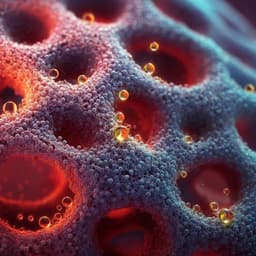
Chemistry
Synthesis of fluorescent organic nano-dots and their application as efficient color conversion layers
Y. Khan, S. Hwang, et al.
Discover the groundbreaking research conducted by Yeasin Khan and colleagues at Kyung Hee University, showcasing fluorescent organic nanoparticles that exceed the performance of traditional quantum dots. These innovative color conversion layers promise unmatched stability and efficiency in display technologies.
~3 min • Beginner • English
Introduction
The study investigates whether ionic and non-ionic surfactants can enable high-yield, uniform, fluorescent organic nano-dots via anti-solvent precipitation and whether such nano-dots can function as efficient, stable color conversion layers (CCLs) for LEDs and displays. Organic NPs offer advantages (facile synthesis, processability, biocompatibility) but have been less explored for optoelectronics and CCLs due to issues like concentration quenching and limited use of surfactants. Prior re-precipitation methods often produce poor uniformity and low yields of small particles. The authors aim to systematically quantify how surfactants (relative to their CMC) influence particle size, morphology, yield, and photophysics, and to demonstrate nano-dot-based CCLs spanning the visible gamut with high color purity, efficiency, and stability as environmentally friendlier alternatives to InP/Cd-based QDs.
Literature Review
The paper reviews: (1) Synthesis routes for organic NPs (emulsification, nanoprecipitation, solvent evaporation), noting sporadic use of surfactants compared to extensive surfactant roles in inorganic NP syntheses. (2) Re-precipitation for organic nano-crystals typically lacks surfactants, leading to poor uniformity/low small-particle yield. Some prior works used surfactants (e.g., AOT, Triton X-100, CTAB; polymerizable surfactants; Pluronic F127) for specific organic NP systems and AIE materials, but a systematic, quantitative analysis of surfactant effects on fluorescent organic NP yield, morphology, and photophysics is lacking. (3) For CCLs, prior materials include phosphors, inorganic QDs, perovskites, and organic dyes. Organic dyes can suffer aggregation quenching and poor photostability; QDs have good PLQY and color purity but face moisture/thermal sensitivity and toxic synthesis. Carbon dots show promise in LEDs. This context motivates exploring surfactant-stabilized organic nano-dots for CCLs with improved stability, processability, and environmental profiles.
Methodology
Nano-dot synthesis: A thermally activated delayed fluorescence (TADF) emitter Ttrz-DI was synthesized and purified (details in SI), dissolved in THF to 0.5 mM. Non-ionic Triton X-100 surfactant was prepared at 0.1 M in THF. Typical preparation: 0.1 mL fluorophore solution plus 0.01–0.5 mL surfactant solution, diluted with THF to 0.6 mL total; then 4.4 mL deionized water was rapidly injected to induce precipitation, giving 5 mL dispersion. Dispersions were filtered (PTFE syringe filters, 450 nm and 200 nm pore sizes), dialyzed (cellulose acetate, 12 h) to remove excess surfactant, then concentrated under ~0.01 Torr on a Schlenk line to remove 90% solvent. The same procedure was used for other fluorophores: TNAP, 4CzIPN, CzDABNA, and 4tBuMB. Surfactant study: Compared ionic TBA oleate (CMC ~0.45 mM) and non-ionic Triton X-100 (CMC ~0.22–0.24 mM). Surfactant concentrations spanning 0.2–10 mM were tested to establish relationships between concentration (relative to CMC), particle size, PL intensity, and yield. Characterization: PL spectra compared among solution, bulk film, and nano-dot dispersions; optical microscopy (OM), fluorescence microscopy (FM), AFM, SEM, and DLS for size/morphology. AFM heights/widths used to infer original spherical particle diameters before substrate deformation; DLS provided hydrodynamic size; SEM imaged dried particles. Yield determination: Generated Beer–Lambert calibration curves (absorbance vs concentration) in THF; filtered aqueous dispersions (through 0.2 and 0.45 μm) were diluted into excess THF and measured by UV–vis to back-calculate molar concentrations; yield defined as moles passing the filter relative to initial moles. Solvent/anti-solvent/temperature tests: Solvents (THF, 1,3-dioxolane, 1,4-dioxane, NMP, N-methyl imidazole), anti-solvents (water, methanol, ethanol, isopropanol, 2-methoxyethanol), and water injection temperatures (25–90 °C) were screened for effects on yield, PLQY, and size. CCL fabrication and testing: Organic nano-dot dispersions mixed into PVA (10 wt% in water) and drop-cast to films (e.g., 160 μm thickness) after sonication; excitation by 400 nm LED inside an integrating sphere. Color conversion efficiency (CCE) calculated by comparing radiant power to pristine PVA films of equal thickness. A reference CCL used InP/ZnSe/ZnS QDs (PLQY 69.7%) dispersed in PMMA with identical molar concentration, polymer concentration, and casting. Stability tests: Accelerated aging under constant UV irradiation for 120 h with periodic CCE measurements; long-term ambient storage (~1 month) with CCE re-measurement. Additional materials synthesis: TBA oleate prepared by neutralizing tetrabutylammonium hydroxide with oleic acid in methanol, followed by ether washes and vacuum drying (5 h).
Key Findings
- Surfactant-enabled nano-dot formation: Nano-dots formed at surfactant concentrations at/above CMC; for Triton X-100, onset ~0.2 mM (near its CMC). Optimal concentration was 6 mM for both Triton X-100 and TBA oleate, yielding smallest sizes and highest PL intensities. CzDABNA showed a minimum size at 8 mM (110 nm), only slightly smaller than at 6 mM (113 nm).
- Particle sizes: Optimal dispersions produced mean particle diameters ~120–165 nm across fluorophores (e.g., Ttrz-DI ~120 nm; CzDABNA ~110 nm; 4tBuMB ~162 nm; TNAP ~165 nm). AFM, SEM, DLS, and OM corroborated trends; SEM sizes appeared smaller due to complete drying; DLS reflected larger hydrodynamic radii.
- Yield: Using 6 mM surfactant, yields of particles <200 nm reached 61.73% (Triton X-100) and 96.3% (TBA oleate) for Ttrz-DI; for other fluorophores, yields approached 100% (<200 nm: CzDABNA 98.5%, 4tBuMB 99.6%, TNAP 98.8%). Yields for <450 nm were ~98–99.9% across materials. Without surfactant, yields of sub-micron particles were negligible.
- Photoluminescence and PLQY: PL peak positions of nano-dot dispersions lay between solution and bulk film states, consistent with intermediate aggregation. Example PLQYs (excitation 300 nm): Ttrz-DI film 85.9%, dispersion 43.4%, solution 70%; CzDABNA film 43%, dispersion 38.8%, solution 61.8%; 4tBuMB 100% in all forms; TNAP film 84.7%, dispersion 60.7%, solution 89.4%.
- Color conversion efficiency (CCE, 400 nm excitation): TNAP 31.1% (highest among organics), 4tBuMB 27.8%, 4CzIPN 19.3%, Ttrz-DI 12.8%. Reference InP QD CCL converted 21.0% of 400 nm to 527 nm. Blue-emitting CzDABNA CCL converted ~4% (demonstrating feasibility across full gamut).
- Spectral purity and color gamut: FWHM values: CzDABNA 21.1 nm (narrowest), TNAP 35.4 nm, 4tBuMB 36.8 nm, 4CzIPN 74.4 nm, Ttrz-DI 87.4 nm. CIE-1931 gamut coverage comparable to NTSC; boron-containing TNAP and CzDABNA achieved 105.96% NTSC area; TADF-based Ttrz-DI and 4CzIPN showed 71.05% and 76.91% NTSC area, respectively.
- Stability: Under 120 h constant UV exposure, relative CCE decay: 4tBuMB <20% (best), 4CzIPN ~40%, Ttrz-DI ~60%, TNAP ~65%, InP QD ~80%, CzDABNA ~85%. Over ~1 month ambient storage, nano-dot CCLs declined only 1–3% in CCE, whereas QD CCLs declined by 52%. Bulk fluorophore films showed lower initial CCE and 30–60% decay over a month vs 0.4–2.3% for nano-dot films.
- Processing conditions: THF as solvent and water as anti-solvent at room temperature produced the smallest sizes and best yields. Alternative anti-solvents (methanol, ethanol, isopropanol, 2-methoxyethanol) gave large particles with negligible yields. Higher anti-solvent (water) temperatures (up to 90 °C) reduced yield and PLQY.
Discussion
The results demonstrate that employing surfactants above their critical micelle concentrations during anti-solvent precipitation transforms organic fluorophores into uniform sub-micrometer nano-dots with dramatically improved yields and controlled sizes. This directly addresses the longstanding issues of poor uniformity and low small-particle yield in surfactant-free re-precipitation methods. The optimized nano-dots, when embedded in polymer matrices, function as efficient color conversion layers with performance that matches or surpasses state-of-the-art InP QDs in conversion efficiency and clearly exceeds them in photo- and shelf-stability. The approach is general across multiple fluorophores enabling coverage of the full visible gamut, including narrow-band boron-containing emitters (e.g., CzDABNA, TNAP) for high color purity and broader TADF emitters (e.g., Ttrz-DI, 4CzIPN) suited to white-light applications. Water-based processing and elimination of toxic heavy metals or phosphines improve environmental and safety profiles, supporting broader applicability in displays and lighting.
Conclusion
Surfactant-assisted anti-solvent precipitation yields fluorescent organic nano-dots with high uniformity and near-quantitative conversion across multiple fluorophores. An optimal surfactant concentration (~6 mM for Triton X-100 or TBA oleate) above each surfactant’s CMC minimizes particle size (≈120–165 nm) and maximizes yield. The resulting water-based nano-dot dispersions are easily processed into films that exhibit high color conversion efficiencies (up to 31.1%), narrow to tunable FWHMs (21.1–87.4 nm), broad color gamut coverage (up to 105.96% of NTSC), and superior photo/shelf stability relative to InP QD and bulk fluorophore CCLs. These properties highlight organic nano-dots as environmentally friendly, stable, and efficient alternatives to conventional CCL materials with strong potential impact on displays and white LED technologies.
Limitations
- Blue-emitting CzDABNA CCL showed relatively low conversion efficiency (~4%) under 400 nm excitation compared to green/red emitters.
- UV stability varied by material; some nano-dot CCLs (e.g., CzDABNA, TNAP) exhibited substantial CCE decay (65–85%) under 120 h continuous UV exposure, though generally still better than InP QDs.
- Optimal performance depended on specific processing conditions: THF as solvent, water as anti-solvent, and room temperature injection; alternative anti-solvents or elevated temperatures reduced yield/PLQY and increased particle size.
- Size determinations varied by technique (SEM vs AFM/DLS) due to drying and hydrodynamic effects; reported sizes reflect method-specific biases.
- Without surfactant, the anti-solvent method produced negligible yields of sub-micron particles, indicating reliance on surfactant presence and concentration control.
Related Publications
Explore these studies to deepen your understanding of the subject.







